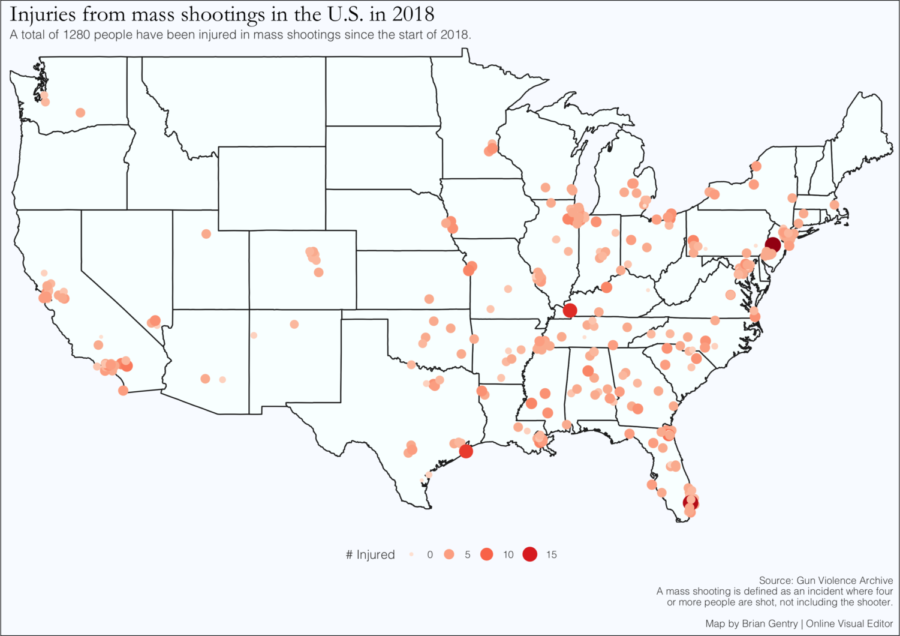Pitt professors explore psychology of mass shooting survivors
November 30, 2018
Prior to 2013, the Diagnostic and Statistical Manual of Mental Disorders said an individual had to be directly exposed to an event to be diagnosed with Post Traumatic Stress Disorder.
But the 2013 Fifth Edition update to the Diagnostic and Statistical Manual of Mental Disorders extended the diagnosis to those who have suffered symptoms from secondhand exposure. This expansion in the medical diagnosis of PTSD gives more insight into the general psychology of mass shooting survivors.
According to Dr. Jamie Hanson, an assistant professor in the Department of Psychology at Pitt, a survivor of a traumatic event does not have to be someone directly affected or injured by the event. He said even an individual who was emotionally affected by news coverage of an event can be considered a survivor.
“It’s really about … personal kind of connection or linkage,” Hanson said. “Some people may have a more distal connection, but still feel really moved by something.”
In regards to the recent mass shooting at the Tree of Life Synagogue on Oct. 27, Hanson said survivors can be people who were injured in the actual event, moved emotionally by media coverage or even an individual who planned to go to services at the synagogue that day — but for one reason or another, didn’t. According to James Andrews, a clinical social worker and coordinator of the Pitt-Johnstown MSW Program, each survivor experiences different reactions to traumatic events, regardless of whether they were directly involved or influenced by media coverage.
“They’re having their own set of emotions,” Andrews said. “All of those individuals also have their own aftermath that they go through.”
Andrews said the onset of psychological distress of direct survivors can occur immediately during the event, when they make a “fight or flight” decision. The stress of this decision heightens the amount of sensory information survivors take in during the event. During this sensory overload, people overcome by fear can subconsciously take in sounds and smells that, when experienced long after the event, can trigger survivors to relive their traumatic experience.
“They may not realize at the moment that they’re hiding under a desk that was just cleaned, so they’re smelling that cleaning solvent,” Andrews said. “Weeks later, they smell that cleaning solvent when they sit down at their desk to do their work, and all of a sudden they’re flooded with the emotions, the physical sensations of hiding under the desk, the intense fear that they felt.”
These sensory triggers causing survivors to re-experience intrusive thoughts and memories of the traumatic event is a common symptom of PTSD, according to Dr. Maria Pacella. Pacella, a health psychologist and research assistant professor of emergency medicine at Pitt, mentioned alongside anxiety and depression, PTSD is among the most common symptoms faced by traumatized survivors and can interfere with how survivors react to certain events in their everyday lives.
“A traumatic event can kind of disrupt those emotion regulation processes,” Pacella said. “If you have a ruminative style of thinking to begin with or you are only focusing on [the event] and keep replaying it in your mind, that’s obviously going to interfere with a normal cognitive processing of the event and can prevent you from moving on.”
Pacella said there are three other characteristic symptoms associated with PTSD — alongside intrusions — that influence day to day reactions of survivors. Two of these symptoms, avoidance and hyperarousal, are negative coping mechanisms that PTSD patients can utilize after a traumatic event in attempt to return to what their lives were like before the event. Hanson said these negative coping mechanisms can hinder a survivor’s day-to-day life.
“They start to avoid others, maybe avoid social situations. They tend to remain kind of particularly hypervigilant as they kind of go out of their way to potentially avoid elements of something that would remind them of the trauma.” Hanson said.
Alongside changes in behavior, Pacella said the fourth characteristic symptom, negative changes in beliefs and feelings, can also occur as a result of PTSD from a traumatic event. According to Pacella, a traumatic event can shift how survivors perceive things that previously brought them happiness, causing them to avoid positive emotions and experiences.
“Trauma can actually change the way that you feel and think about yourself and others,” Pacella said. “You might withdraw in your relationships, you might feel a sense of shame and guilt … you might not trust people anymore. You might think the world is a completely dangerous place, and you can’t get over that part of it.”


Despite the troubling symptoms of PTSD that survivors may face, there are recovery resources available. But Pacella said the length and effectiveness of the healing process can vary between every survivor since everyone deals with trauma in their own way.
“Some people want to talk about [the event] right away, and some people need time,” Pacella said. “For other people who maybe weren’t directly involved, it might actually be helpful going to the scene and seeing what they can do to help.”
Pacella said there are a variety of different resources and methods survivors experiencing PTSD can utilize to recover. For example, in cognitive processing therapy, survivors can come to terms with how their trauma affected them and their feelings and develop strategies to overcome barriers to recovery any negative sentiments. Pacella said another treatment, called “prolonged exposure,” is a more intensive option where patients are presented with the opportunity to talk about the traumatic event with a therapist until it’s no longer upsetting.
Positive coping is another mechanism survivors can utilize. Hanson said survivors who suffer from PTSD often exhibit both positive and negative coping methods, but concentrating on positive methods while avoiding negative ones can lead to recovery.
“A more positive way of thinking about this is that people can think about the likelihood and the commonality of these types of experiences,” Hanson said. “People went to vigils and marches … I think of all of those things is more on the positive end of coping.”
Traditional treatments with psychologists don’t have to be the only option for traumatized survivors. Dr. Christina Newhill, a professor of social work at Pitt said speaking with social workers is another helpful resource survivors can use in conjunction to speaking with psychologists to heal. Newhill said the holistic approach social workers use in conjunction with their specialized training allows them to approach traumatized survivors more efficiently and examine how the environment a survivor is in affects them.
“Social workers are often uniquely trained to deal with families, to deal with victims of trauma with an understanding of the environment and what environments can be healing for them,” Newhill said. “In our department, students learn how to engage in trauma-informed care to actively recognize that when you’re working with a client that there may be a history of trauma, and that you want to inquire about that and take that into consideration in the services that you provide.”
In terms of preparing for an event such as a mass shooting and avoiding psychological symptoms like PTSD, Andrews believes training the public to respond rationally to such events through active shooter drills is a step in the right direction. Newhill said active shooter drills are helpful — but she said it’s not feasible for people to anticipate such a traumatic event at all times.
“What’s happening with these with many of these mass shootings is that they are being carried out in places where people think that they’re safe — schools, churches, synagogues, movie theaters,” Newhill said. “I think in some level you can’t prepare for that, because we don’t want to live in a police state where you go through security at every juncture of your life.”



